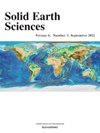用TIMS和MC-ICP-MS测定了18种中国地质标准物质的锶钕同位素组成
IF 2
4区 地球科学
Q3 GEOSCIENCES, MULTIDISCIPLINARY
引用次数: 0
摘要
本文介绍了用TIMS和MC-ICP-MS分别测定的18种中国地质参考物质的放射性Sr-Nd同位素组成。这些RMs包括9块火成岩、6块沉积岩、2块变质岩和1块河流沉积岩。其中,首次报道了8个Nd同位素比值和3个Sr同位素比值。结果表明,TIMS和MC-ICP-MS测量的Sr和Nd同位素比值在误差范围内是一致的。我们还观察到,在TIMS测量过程中,使用灯丝燃烧技术可以显著减少Rb干扰,这对获得准确的Sr同位素数据具有重要意义,特别是对于高Rb含量的样品。为了评估均方根的均匀性,我们将来自不同实验室的Sr和Nd同位素数据聚集在一起进行比较分析。总的来说,除了一些异常情况外,这些来自不同实验室的均方根得出了相对一致的比率。我们认为等压干扰可能是导致同位素不一致的主要因素。因此,我们认为这些均方根值是Sr和Nd同位素分析的可靠候选者。这些数据集将在放射性成因Sr和Nd同位素系统的质量保证和比较中发挥基础性作用。本文章由计算机程序翻译,如有差异,请以英文原文为准。
Strontium–Neodymium isotopic compositions of eighteen geological Chinese reference materials measured on TIMS and MC-ICP-MS
This study presents radiogenic Sr–Nd isotopic compositions of eighteen geological Chinese reference materials (RMs) measured on TIMS and MC-ICP-MS independently. These RMs include nine igneous rocks, six sedimentary rocks, two metamorphic rocks, and one fluvial sediment. Among the RMs, eight Nd isotopic ratios and three Sr isotopic ratios of them are first reported. Our results showed that the Sr and Nd isotopic ratios of these RMs measured on TIMS and MC-ICP-MS are consistent within the error range. We also observed that Rb interference can be dramatically reduced using filament burning technique during TIMS measurement, which is significant to achieve accurate Sr isotopic data especially for samples with high Rb content. To evaluate the homogeneity of RMs, Sr and Nd isotopic data reported from various laboratories were clustered together for comparative analysis. Overall, these RMs from various laboratories yielded relatively consistent ratios, except for some anomalies. We concluded that isobaric interference could be probably the main factor that induced the isotopic inconsistency. Therefore, we propose that these RMs are reliable candidates for Sr and Nd isotope analyses. The datasets will play a fundamental role in quality assurance and comparison for radiogenic Sr and Nd isotopic systems.
求助全文
通过发布文献求助,成功后即可免费获取论文全文。
去求助
来源期刊

Solid Earth Sciences
GEOSCIENCES, MULTIDISCIPLINARY-
CiteScore
3.60
自引率
5.00%
发文量
20
审稿时长
103 days
 求助内容:
求助内容: 应助结果提醒方式:
应助结果提醒方式:


